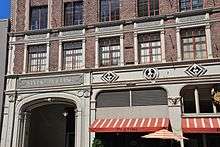Ellison-White Conservatory of Music
The Ellison-White Conservatory of Music was a music conservatory in Portland, Oregon, United States, associated with the Ellison-White Lyceum and Chautauqua Association.[1] The conservatory advertised itself as "answering a need" for a "Standard Conservatory of the Fine Arts" on the U.S. West Coast.[2]

The conservatory opened in 1918 in the Broadway Building, subsequently relocating to northeast Portland. In 1927, the conservatory constructed the nine-story Studio Building in downtown Portland, after which it formally closed some time in the 1940s.
History
Founded by J.R Ellison and Clarence White, the Ellison-White Conservatory was originally located in the Broadway Building in downtown Portland,[3] and held its first classes on September 9, 1918.[3] The conservatory was associated with the Ellison-White Lyceum and Chautauqua Association, which had originated in Boise, Idaho.[4]
The conservatory advertised itself as answering a need for a "Standard Conservatory of the Fine Arts" on the U.S. West Coast.[2] By 1920, the conservatory had relocated from the Broadway Building to a location on Everett Street in northeast Portland.[2][5] In 1922, the conservatory expanded its voice department.[6] In 1927, the conservatory constructed the historic nine-story Studio Building in downtown Portland, located at SW 9th and Taylor, relocating their operations there.[7] The Studio Building had more than 100 rehearsal studios, sound-proof walls, and was attached to the 450-seat Guild Theatre.[8]
The conservatory was closed by the Ellison-White Lyceum and Chautauqua Association some time in 1940s after the Great Depression, though the exact date is unknown.[lower-alpha 1]
Notable people
Alumni
- Walter Chappell, photographer[14]
- Beverley Peck Johnson, vocal coach
- Helen Kleeb, actress[15]
- Jeanette Loff, film actress, singer, and organist[16]
Faculty
- Pauline Alderman, musicologist[17]
- Jacques Gershkovitch, flautist and conductor[18]
Notes
- The exact date the conservatory ceased operations is unknown. In an Oregon Historical Quarterly article from 1984, Donald Abbott states the conservatory was closed "in the 1930s, likely due to the Great Depression."[9] This is disputed by several sources, however, including an article from the Music Educators Journal from October 1936 that indicates the conservatory was open at date.[10] Subsequent contemporaneous newspaper sources indicate the conservatory was still in operation at least during the early-1940s.[11][12][13]
References
- Lush, Paige (2013). Music in the Chautauqua Movement: From 1874 to the 1930s. Jefferson, North Carolina: McFarland. p. 28. ISBN 978-1-476-60619-4.
- "Answering a Western Need". The Kendrick Gazette. Kendrick, Idaho. May 28, 1920. p. 7 – via Newspapers.com.

- "Fall School Term Opens Sept. 9th". The Oregon Daily Journal. Portland, Oregon. August 18, 1918. p. 30 – via Newspapers.com.

- Parlet, Tanya (ed.). "Clarence H. White papers, 1898-1945". Archives West. Retrieved January 4, 2019.
- "Ellison-White Music Catalogue Outlines Planes". The Oregon Daily Journal. Portland, Oregon. August 21, 1921. p. 41 – via Newspapers.com.

- "Ellison-White Conservatory of Music Announces A New and Enlarged Plan for the Voice Department". The Oregon Daily Journal. Portland, Oregon. May 7, 1922. p. 48 – via Newspapers.com.

- "Midtown Blocks Historic Assessment". PortlandOregon.gov. City of Portland. 2004. pp. 99–100. Retrieved January 4, 2019.
- "New Life for the Guild Theater?". Architectural Heritage Center. Archived from the original on January 4, 2019.
- Abbott 1984, p. 307.
- "Northwest Conference". Music Educators Journal. The National Association for Music Education. 23 (2): 40. October 1936.
- "Portland Girl Flutist in Solo on World Air Program". The Capital Journal. Salem, Oregon. June 13, 1940. p. 20 – via Newspapers.com.

- "Six Corners". The Bulletin. Bend, Oregon. October 15, 1941. p. 6 – via Newspapers.com.

- "Student Group Is Presented". The Capital Journal. Salem, Oregon. July 3, 1942. p. 5 – via Newspapers.com.

- Gunno (1988). Fotofest: The International Month of Photography. Fotofest. p. 154. ISBN 978-0-961-97660-6.
- Johnson, Jimmy (August 18, 1977). "Two Sisters Have 'The Recipe'". The Burlington Free Press. Burlington, Vermont. Gannett News Service. p. 27 – via Newspapers.com.

- "Jeanette Loff, a Pure Nordic Blonde, Enjoys Music and Skiing as Hobbies". The Leaf-Chronicle. Clarksville, Tennessee. June 21, 1930. p. 8 – via Newspapers.com.

- Karson, Burton L. (1976). Festival Essays for Pauline Alderman: A Musicological Tribute. Provo, Utah: Brigham Young University Press. p. viii. ISBN 978-0-842-50101-9.
- Avshalomov, Jacob (1979). Music is Where You Make It, II: The Joyful Workings of America's First Youth Orchestra, the Portland Youth Philharmonic. Portland, Oregon: Portland Junior Symphony Association. OCLC 7157372.
Sources
- Abbott, Donald P. (Fall 1984). "Ellison-White Chautauqua". Oregon Historical Quarterly. Oregon Historical Society. 85 (3): 304–307.CS1 maint: ref=harv (link)
External links
| Wikimedia Commons has media related to Ellison-White Conservatory of Music. |
- Works by or about Ellison-White Conservatory of Music in libraries (WorldCat catalog)